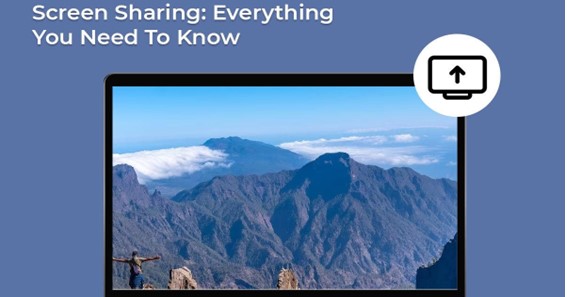Screen sharing makes remote collaboration on documents fuss-free. It even lets you demo products, co-browse, on-board new employees or customers, and more. But if done poorly, screen sharing can turn into a nightmare.
For the longest time, there used to be separate screen sharing applications. So, downloading an application of your choice would help you share your screen with your colleagues or clients. But given the importance of screen sharing and how it boosted collaboration during the pandemic-induced lockdowns, many video call applications have started offering this feature, such as Zoom and Skype.
But do you know how exactly screen sharing works? What does it mean? Is it safe? If these questions are ricocheting your mind, find the answers here.
What is Screen Sharing & Screen Sharing Software?
Screen sharing is sharing access to your computer screen with someone else remotely. The other person can see all the real-time activity happening on your screen. The screen sharing feature is handy when people need to give virtual presentations, during online meetings, or when on-boarding new employees.
When screens are shared during meetings, it saves time and helps everyone to view the same document at the same pace and at once. There’s no need to send the document or file around.
To share the screen, you would need a screen sharing software. This collaboration tool lets an audio or video call participant show their computer screen to everyone else on the call. Everyone can see the real-time actions happening on the shared screen. Screen sharing software is sometimes also referred to as desktop sharing.
There are several screen sharing software at your disposal with screen-sharing capabilities. Some of the top screen sharing technologies include Skype, Slack, Zoom, Microsoft Teams, and Google Meet.
When choosing the screen sharing platform, you must consider security features your top priority.
Mistakes to Avoid when Sharing Your Screen
- Not turning off notifications or minimizing chat windows
One of the most common and potentially damaging mistakes you can make when sharing your screen is leaving your notifications, alerts, and chat windows on. This can be highly distracting and annoying. Also, they may reveal personal information during video calls that you might not want your team to know. For instance, your doctor’s appointment or that you have an upcoming holiday.
Moreover, leaving your alerts and notifications looks unprofessional.
Hence, before sharing your screen, ensure to turn off all notifications and alerts. You must also minimize or close all chat windows and begin the meeting.
- Not being prepared
It can be awkward for you if you don’t know which materials you want to show or which technology you want to talk about. Also, not knowing which software to use during a meeting can create a less-than-appealing impression in front of your colleagues or clients. What’s worse is that going unprepared for a meeting and sharing the screen results in inefficient use of everyone’s time.
Therefore, you must start every meeting with complete preparation. You must know what screens you want to share and what you want to talk about. Ensure all the files you want to share are easily accessible. Set up your computer for screen sharing by queuing up all the documents so you don’t end up fumbling during the meeting and wasting productive hours.
- Having a cluttered desktop
Sharing your screen while your desktop is messy can potentially tell your colleagues and clients that you are a disorganized person. Also, with the names of the folders and files on display, you might inadvertently give away the names of the clients or projects you are working on. Or if you have changed the wallpaper to something private, you risk letting everyone get a glimpse of it.
Therefore, before sharing your screen, you must organize your desktop and ensure there’s nothing on it that you don’t want to show to your clients or colleagues. Put all the sensitive files and documents in a folder. You can hide the folder as well. Also, remember to replace the wallpaper if it’s private and use something work-appropriate.
Click here – What Race Is Klay Thompson?
Screen sharing has been around for a long time, but it does have some potential security threats. For instance, sharing your screen with someone unknown might put your data at risk. Also, not using the right software when sharing your screen may compromise the safety and privacy of your device.
The solution is to share your screen with trusted individuals and use screen sharing software after thoroughly vetting it. You must check the software’s security features and ensure they match your expectations.
Final Thoughts
Screen sharing is an essential collaboration tool, especially for remote workers. Be careful when sharing your screen, and always be prepared. Share your screen cautiously so you don’t give away too much personal information.
